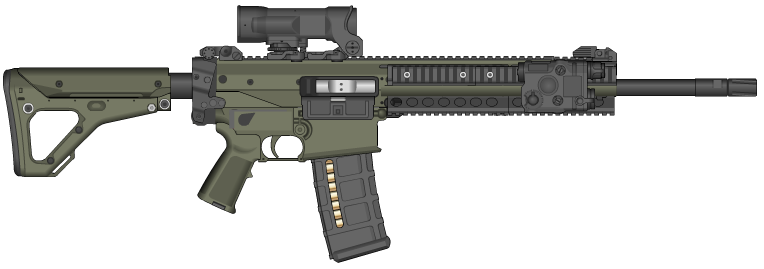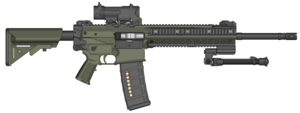AMW-280 assault rifle
| AMW-280 | |
|---|---|
 | |
| Type | Assault Rifle |
| Place of origin | Astronea |
| Service history | |
| In service | 2012-present |
| Used by | Astronean Armed Forces |
| Production history | |
| Designed | 2008-2010 |
| Manufacturer | ACC Defence Division |
| Unit cost | $1,100 |
| Produced | 2011-present |
| Variants | AMW LSW, AMW DMR, AMW-280C |
| Specifications | |
| Length | 586 mm (23.1 in) |
| Barrel length | 400 mm (16 in) |
| Width | 76 mm (3.0 in) |
| Height | 240 mm (9.4 in) |
| Shell | .280 ACC |
| Shell weight | 139 gr (9.0 g) |
| Action | Short-stroke gas piston, rotating bolt. |
| Rate of fire | 750 rounds/min |
| Muzzle velocity | 830 m/s (2,700 ft/s) |
| Effective firing range | 500 m (550 yd) |
| Maximum firing range | 700 m (770 yd) |
| Feed system | 30 round detachable box magazine |
| References | |
The AMW-280 (Adaptable Modular Weapon) is a modern intermediate caliber assault rifle designed as a direct response to growing needs for a cartridge capable of providing comparable bullet velocity to large caliber rounds, with the recoil and compact size of a smaller cartridge. Firing the revolutionary .280 ACC, the AMW boasts ballistics comparable to a 7.62 battle rifle and the control and compact size of a 5.56 carbine. This allows the rifle to outperform other contemporary rifles in terms of range, bullet velocity and stopping power, without compromising weight, magazine capacity or maneuverability. The AMW-280 is a modular rifle, with lightweight parts and the ability to fulfill a wide variety of roles.
History
Since 1964, the primary service rifle of the Astronean Armed Forces has been the AM-64, a highly reliable model weapon firing the formidable 7.62x39mm round, with options for downscaled calibers and a later modularization to the 7.62x51mm round with the introduction of the A1A1 TSK three years later. Together, these two weapons served Astronea's needs in many theaters across the globe. Renowned for their reliability, firepower and general accuracy, the TSK and AM-64 became iconic in the images of the most distinguished infantry units of Astronea's ground forces, the Astronean Rifles, among other veteran units. Various modernization programs over the years have brought the rifles up to standard with developing small arms technologies, most notably the OSW and the AM-95, with integrated rail systems, improved firing mechanisms, polymer parts and erganomic improvements.
However, as the AAF moved forward into 2016, the annual defence review called for a possible replacement for the two rifles, a single modular design that would eliminate the need for both rifles and multiple calibers.
The Ministry of Defence put forward the following criteria:
"Requirements: RIS, lightweighting, a carbine, LSW and DMR variant, a short stroke piston action and collapsable stock, cold forged steel and polymer, free floating barrel."
In addition to the demands by the Ministry of Defence, the government approved the development of a new intermediate cartridge, an updated design left from the 1970s, which had ballistics comparable to the most powerful rifle rounds of that time, notable the .308 and 30-06. The result was 6.25x45mm, otherwise known as the.280 round. The new ammunition swept the floor with other intermediate cartridges such as the 5.56x45mm in terms of range, ballistics and energy, while providing less than half the recoil of the 7.62x51mm round currently being fielded at a similar muzzle velocity.
Initial results were mixed, first with a bullpup configuration being considered. When these designs were shown to be too clunky and counter intuitive for the standard soldier, conventional designs began to take form. The XMW-280 (experimental designation) had initially used a carbon fiber barrel to reduce weight. This however caused reliability issues due to increased wear on the barrel, resulting in rounds not feeding correctly when chambered. A cold forged steel barrel increased reliability and accuracy considerably.
Final concept designs were submitted to the MoD evaluation board in early 2009, with LSW and DMR variants following shortly. Following extensive field trials, the AMW-280 and all its variants were formally adopted in 2010, with full scale production beginning immediately after. Officially entering service in 2012, the AMW-280 formally replaced the AM-96 as the main service weapon in 2015 following gradual phasing out of the older rifle. The AMW-280 has seen action with the Astronean Expeditionary Force in various hot and cold weather climates, and has been used extensively on the homefront of Astronea's borders, defending against skirmishes from hostile neighbouring countries.
Design
The AMW-280 uses a ACC-proprietary short-stroke gas piston system designed specifically for the weapon platform. The system uses a short-stroke piston driving an operating rod to force the bolt carrier to the rear. This design prevents combustion gases from entering the weapon's interior—a shortcoming with direct impingement systems. The reduction in heat and fouling of the bolt carrier group increases the reliability of the weapon and extends the interval between stoppages. During factory tests the XMW-280 fired 10,000 rounds in full-auto without malfunctioning. It also reduces operator cleaning time and stress on critical components.
The AMW-280 uses polymer materials in its construction to reduce weight, notably on its picatinny rail/RIS, stock, pistol grip and parts of the receiver.
The barrel of the rifle is cold hammer forged, meaning that the rifling and forging of the barrel took place at a lower temperature than normal processes, up to 80% cooler. Specially shaped metal components known as "hammers" then barrel blanks into shape to make the rifle take form.
The forging process not only shapes the barrel but strengthens it as well. The repeated blows by the hammers align the molecular “grain” within the metal, increasing rigidity and strength.
The last, but important, part is that a mandrel and reamer are used to form the chamber, bore and rifling as the hammers pummel and elongate the barrel.
Using cold hammer forging to manufacture the barrel saves significantly in material and final machining, is a high productivity method and results in excellent dimensional accuracy and surface quality of cold extruded parts. This leads to improvements in the mechanical properties of extruded parts and an increased toughness due to the crystal grain flow from the process.
The barrel itself is attached to the AMW-280's receiver, which is attached to the stock, but the barrel floats freely without any contact with other gun parts, other than the rifle's sights. This minimizes the variance in possible mechanical pressure distortions of the barrel alignment, and allows vibration to occur at the natural frequency consistently and uniform shot-by-shot, significantly increasing the weapon's accuracy.
.280 ACC ballistics
The proprietary cartridge of the AMW-280, .280 ACC offers comparable penetration, muzzle velocity, range and accuracy to that of its higher caliber competitors, while giving much less felt recoil per shot, allowing for better sustained and automatic fire, as well as shooter comfort. This allowed magazine capacity to remain at higher than any large caliber battle rifle, while still retaining power and velocity, with no cost to controlability.
The .280 ACC is a rimless bottlenecked cartridge of 7mm proportions, and comes in several configurations. AP (130 gr or 8.4 g), API (130 gr or 8.4 g), Ball (130–140 gr or 8.4–9.1 g), Observation (130 gr or 8.4 g) and Tracer (130 gr or 8.4 g).
As shown by the data, .280 ACC is capable of competing against larger caliber rifles at a fraction of the recoil energy and bullet weight.
Variants
AMW-280C
AMW-280C | |
|---|---|
 AMW-280C carbine |
A carbine variant of the AMW 280, featuring shorter barrel length and superior erganomics, fielded by Astronean Light Infantry (paras) and vehicle crews. The C variant has a total length of 15.7 in (stock extended), allowing the weapon to be used in tighter spaces. As such, the weapon has found use among Special Forces units as well as armed Police units, who favour maneuverability over longer range. Erganomic grips come as standard with each unit.
It was found that the erganomics and weight of the round maintained a comfortable shooting experience for the user, with very little added "jump" from the weapon's reduced weight. Field experience revealed that the 280C was capable of hitting targets well beyond its predicted range when in the hands of a skilled shooter, and that its reduced weight allowed for faster aiming and target acquisition. Its concealability has also become a desirable trait for users who require compact rifle caliber weapon for both versatility and sustained firepower.
AMW-DMR
AMW-DMR | |
|---|---|
 AMW-DMR designated marksman rifle |
The primary designated marksman rifle version of the AAF, the AMW-DMR is a semi-automatic version with a 20 inch barrel, equipped with a 4X optical sight, extended stock and bipod for long-range engagements. Standard procedure is to equip every squad with one DMR for individual target elimination. It is estimated a well trained marksman can eliminate one enemy per every three shots within a seven hundred metre range in the right conditions. While 30 round capacity magazines are available for all variants of the AMW-280, DMR variants are typically issued with 20 round magazines in order to conserve ammunition and retain a more comfortable shooting profile from a prone position.
During field use it was discovered that the AMW-DMR was competing on-par with its 7.62x51mm predecessor; the TPS TSK DMR, in terms of accuracy, stopping power and even range. The AMW-DMR has become a fast favourite with AAF marksmen as well as counter-terror units. The DMR is able to lay down sustained and accurate fire, its lower recoil round allowing for rapid target-reacquisition and follow up shots. There are numerous reports of marksmen place two center-of-mass shots into enemy targets in rapid succession, before the target had even hit the floor.
AMW-LSW
AMW-LSW | |
|---|---|
 AMW-LSW light support weapon |
The AMW-LSW is the standard light support weapon of the AAF. It features a longer barrel and a bipod for greater range and accuracy. The LSW is capable of a high rate of accurate sustained fire at ranges up to 1,000 meters, making it a significant force multiplier in firefights. Its weight and detachable-box magazine offer a distinct advantage over belt-fed LMGs, being lighter and faster to reload. Typically the AMW-LSW is fielded with 45 round magazines, but a 65 round Beta-C drum magazine is available for extended sustained fire.
The LSW bridges the gap between LMG and assault rifle, offering a more maneuverable alternative to LMGs, while providing the fire support role that a standard assault rifle lacks. Parts commonality and shared ammunition between all weapon variants means that logistical problems are kept to a minimum, as all weapons share the same ammo and interchangeable parts.